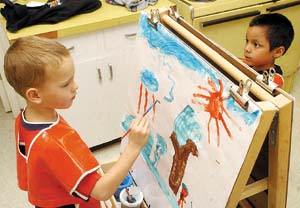Bitterwater-Tully, a tiny rural school in the far reaches of
southern San Benito County, remains unscathed by the passage of
time. Visitors to the two-room school house, filled with only 29
studetns and two teachers, may think they have traveled back in
time to bygone era when discipline problems were rare and students
attended school simply to learn.
Hollister – Bitterwater-Tully, a tiny rural school in the far reaches of southern San Benito County, remains unscathed by the passage of time. Visitors to the two-room school house, filled with only 29 studetns and two teachers, may think they have traveled back in time to bygone era when discipline problems were rare and students attended school simply to learn.
And learn they do. Bitterwater-Tully School District has the highest standardized test scores in San Benito County, but numbers don’t mean much to Principal Tim Williams. He uses a slightly different method to gauge his own performance.
“I’m successful if my students are successful in high school,” he said. “That’s my yard stick.”
A combination of good teachers, hard-working students and community support make the school successful, Williams said. On the state’s Academic Performance Index, Bitterwater-Tully scored 890, a feat that is particularly impressive considering that only 27 percent of schools statewide were able to score above 800. The API ranks California’s public schools based on students’ performance on the state’s standardized tests. Schools are ranked on a scale of 200 to 1000.
Bitterwater-Tully, one of seven rural school district’s in the county, serves kindergarten through eighth grade students. An hour from Hollister, Bitterwater-Tully is isolated from all other schools in San Benito County. Most of the school’s students grow up on ranches in the vast hills surrounding the school and bring an old-fashioned, simple and hard working attitude to class every day. They don’t talk back to their teachers – in fact the school doesn’t have discipline problems – and learn in groups of two or three. And on the playground, everyone plays together regardless of grade level.
Bitterwater’s student population is also unique, kindergarten through third grade teacher Rose Mary Rochholz said.
“You ask them what their father does and they say, ‘He’s a cowboy,'” Rochholz said. “And it’s true.”
Most Bitterwater-Tully students are raised on farms or ranches in the hills surrounding the school and come to kindergarten with a strong work ethic, she said.
“They’re used to working because they have chores at home,” Rochholz said.
Because disciplinary problems are rare at Bitterwater-Tully, instructional time is almost never interrupted.
“It’s because (Bitterwater-Tully) is the way school’s were 50 years ago,” Rochholz said. “It’s fun, we laugh a lot and the kids are just so good.”
Over the course of the school’s 130-year history, much has changed at Bitterwater-Tully, but some things, such as its commitment to academics, remain intact, said Board of Trustee member Donna Palmer, who attended the school from 1942 to 1950.
“As far as teaching and education go, it hasn’t changed much,” she said. “And I believe Bitterwater-Tully will be here forever because we will always be able to attract new students with our educational program.”
Although small rural schools have many advantages, only having 29 students isn’t always a good thing, according to some students. Natalie Madson, Sierra Sans and Katie Donham, three veterans on the school’s championship volleyball team, said they were lucky this year because they have enough players to form a team. The team, which competes in a league with other small middle schools, had to recruit several fifth graders in order to take the court last year and win their division championship.
“(Winning) was very exciting,” Sans said. “This year we have two new players and we won’t lose any.”
Although the school has been around for more than a century, funding is always a concern. Last year the school only had 24 students and could not get enough funding from the state to hire two teachers. In a school with two classrooms, one for kindergarten through third grade and another for fourth through eighth grade, having two teachers is vital, Rochholz said. In order to pay for a second teacher last year the school had to dip into its reserves. This year, thanks in part to nine students who transferred into the district from other schools, Bitterwater was able to afford two teachers, Rochholz said.
Bitterwater-Tully has been able to remain solvent, even in times of low enrollment, because of sapient financial planning, County Superintendent of Schools Tim Foley said.
“We always have a concern for their long-range plans,” Foley said. “One family moving out of the district can make a big difference.”
School funding is based on average daily attendance, so when one student leaves, the district stands to loose about $4,000, according to the California Department of Education’s funding model. In a district that brought in only slightly more than $164,000 in revenue last year, every dollar counts, Foley said.
Despite ongoing funding concerns, Foley believes the district is in good financial shape and will be able to continue operating for many years to come, just as it has for the last century.
“At Bitterwater-Tully, no kid can fall through the cracks,” he said.
Brett Rowland covers education for the Free Lance. He can be reached at 831-637-5566 ext. 330 or [email protected].










